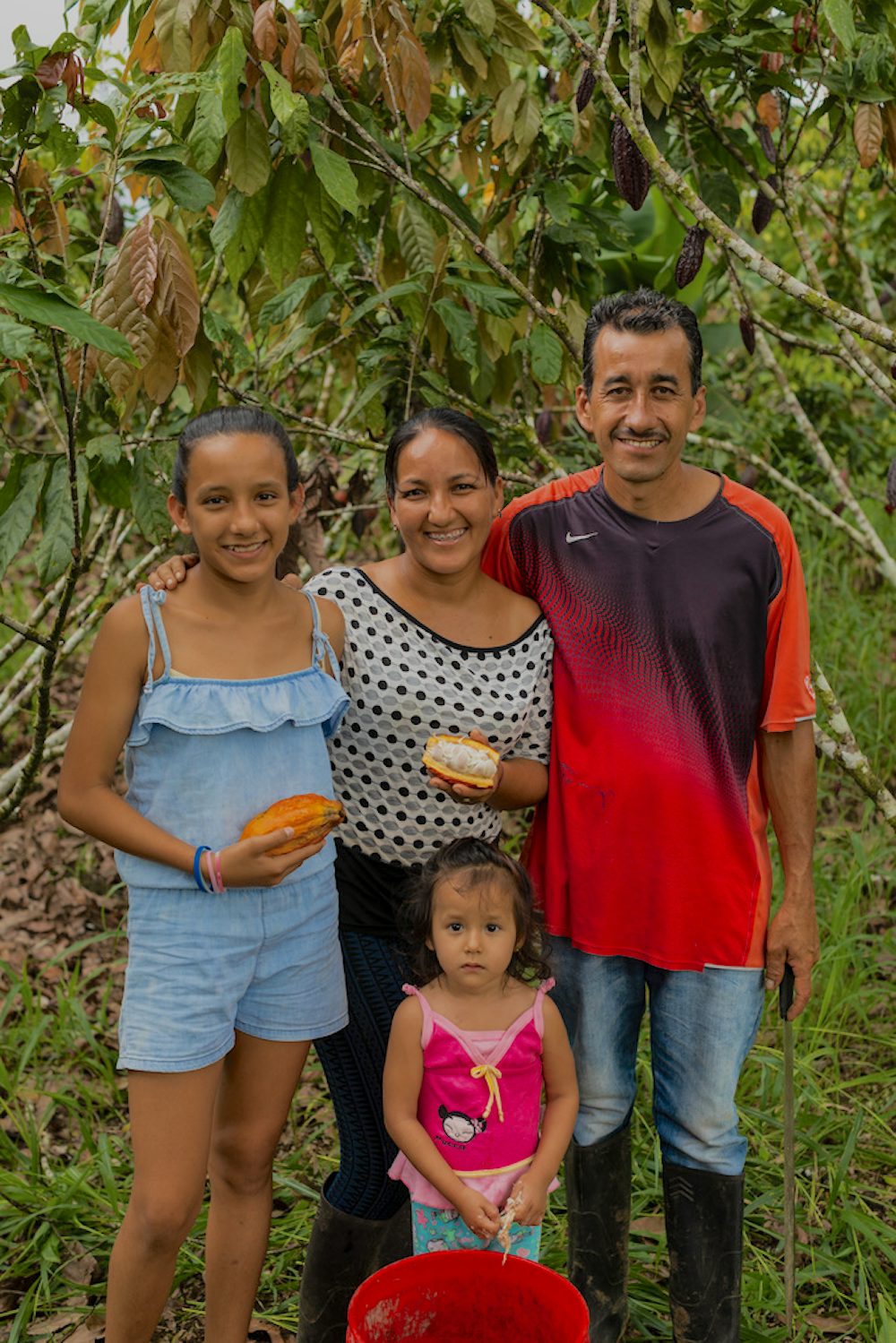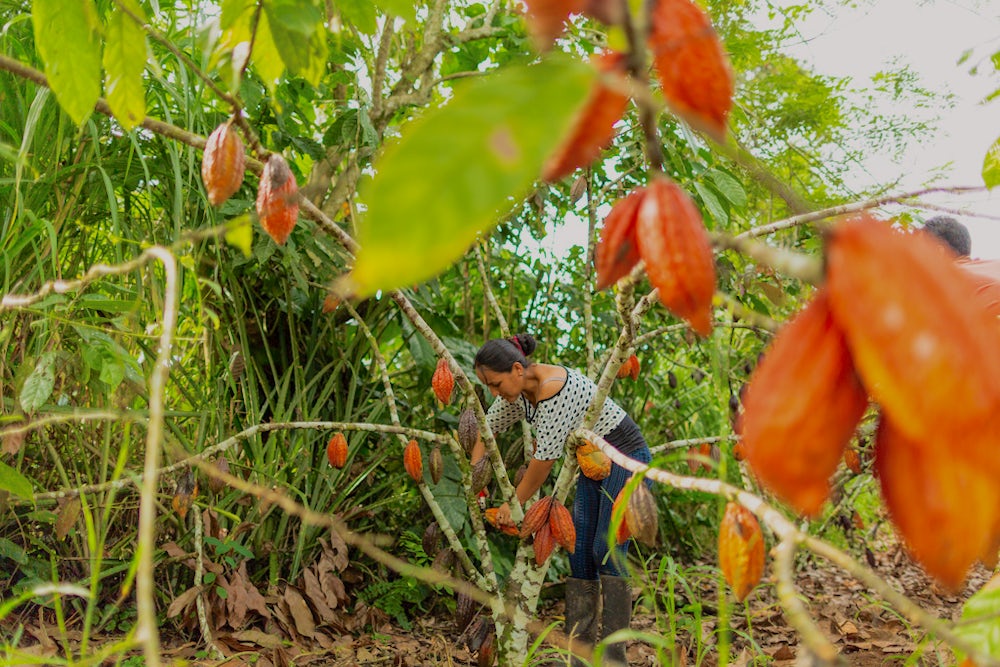The world is in love with Amazonian chocolate. Heifer Ecuador is making sure chocolate loves its farmers back.

Shushufindi, Ecuador — It’s harvest time in the family chocolate grove. Young trees burst with full greenery, and cacao pods hang all over them in warm shades from sunset golden and orange to deep red, like full hearts.
Farmer Digna Magdelena Silva Narváez surveys her success proudly, with her husband and two daughters looking on. This sweet picture of family togetherness was hardwon. Silva grew up in the countryside, which for her is the Amazon rainforest. She treasured her childhood on the family farm in Shushufindi, Ecuador, which she blames particularly on her father, with whom she is very close. “It’s his fault that I love the farm,” he laughs. When she tried to make a go of it in the city with her husband and a young daughter, they were unhappy.
“We were living in town for six years, and that was very hard for all of us because I couldn’t be with my daughter,” said Silva. “I had to get out of the house at 6 in the morning, and I left her with my sister-in-law. And I got home at 7 at night, and she was already asleep. So, I only saw her when she was asleep. Now, I have my little girl, and she can be with me in the field. She gets dirty but nothing else bad happens,” Silva laughed. “We’re together. The family’s together.”
Silva and her husband, Roberth Andrade, now have two daughters, Angie Paula Andrade Silva, 13, and Lina Jared Andrade Silva, 2. Moving back to the farm had its own difficulties, namely, how to make a living. “When we came here, it was hard because we purchased this [land] by taking a loan,” said Roberth Andrade. “So, we were working on borrowed money, and the worst thing was that there wasn’t employment anywhere.”
Things turned around when the family tried their hand at cacao. “This [cacao] has helped us a lot,” Silva said. “It’s just one little hectare [about 2.5 acres] there, but that has provided enough for our own food.” Silva and Andrade planted a varietal of cacao they call “supertree.”

They and many other growers are hoping this particular cacao tree can help solve some of the serious issues in the world trade of chocolate. There are three genetic lines of cacao tree dominant in Ecuador. One, fine aroma cacao or Criollo, produces the best, most complex flavors. But these trees are delicate and difficult to grow, unsuited to the moisture of the Ecuadorian Amazon and therefore grown almost exclusively on the coast. The most common variety of cacao is overwhelmingly Forastero, which constitutes at least 80 percent of world production. It’s the heartiest and easiest variety to grow, but its flavor is not so great. Big candy companies buy this kind in bulk, and make up for the lacking flavor by mixing in lots of milk, sugar and other ingredients in the candy. West Africa is the greatest supplier of this echelon of chocolate, and in fact produces two-thirds of the world’s chocolate.
.jpg?or=0&q=60&crop=faces,entropy&auto=format&fm=jpeg&shad=50&vib=20&duotone-alpha=40&duotone=000000,2CFFD4C6&w=1000)
So, where does that leave families like Silva’s and their chocolatales (chocolate forests)? After all, after much debate, recent genetic testing has revealed that Amazonia is the birthplace of cacao. This is where Trinitario, or supertrees, might save the day. These are types of hybrids between Forastero and Criollo, hardier than their fancy Criollo relative but still imbued with the complex bouquet and adventurous flavor characteristic of Latin American cacao. Much like wine, quality chocolate has a potent orchestra of flavorful notes all its own, from smoky undertones, floral notes or punches of citrus. When native Latin American chocolate is allowed to grow among the other tropical flora natural to its habitat, the chocolate inside absorbs the heady aroma and exotic tastes of the forest around it. But as the rest of the world is rediscovering the divine taste of Latin American chocolate, the majority of cacao farmers in the world continue to live in poverty. Much like the coffee industry, the high prices consumers pay for the end product get lost in the mix and very little makes it to the people who actually grow it. It’s a far cry from the origins of chocolate in Mesoamerica, when the value of cacao was so well appreciated that the beans were used as currency by both the Mayan and Aztec empires.
Heifer is working with families like Silva’s to get better prices for their cacao by improving the quality of tree, teaching organic growing practices and connecting them to the right markets for their wares. But growing cacao, of course, take time. Families in an immediate crisis of poverty now need a stopgap between their long-term business plan with chocolate and their urgent needs. That’s why part of the Heifer project is helping participants diversify their farming businesses into raising fish and pigs, which are good extra income and perfect for immediate emergency funds.
“It’s beautiful. Because not everyone has that good fortune. Because they have to go away for work. They have to be separated. But we’re together." – Digna Silva, 31
On the chocolate side of things, cacao-growing families are now selling to local farmers markets and fairs and also to larger local players like Ecokakao. As the name suggests, Ecokakao is a company driven by sustainability, and the organic and sustainable practices Heifer project participants use to grow their cacao makes them a perfect partner. To that end, Silva’s group developed their own brand for the chocolate products they make from their cacao supertrees, and they named it, aptly, “The Solution.” And it’s working. “The change that we’ve had,” said Silva, “when we go out to market fairs, they recognize us — oh, you’re the Heifer project, oh you’re the chocolate lady! Because of the value add that we’ve made. We’ve had the opportunity to go to market fairs in the capital, in Quito.” Silva’s co-op has been sending their cacao to a third party to be processed and made into chocolate bars, but now they want to make their own bars. Heifer is helping them get the equipment and training they need to own the processing part, too. “Our vision is to be able to sell the chocolate in the big markets,” she said.

After the hardship of their early marriage in the city and stressful first years in the country, things are finally coming together for Silva and family. “It’s beautiful. Because not everyone has that good fortune. Because they have to go away for work. They have to be separated. But we’re together,” she said. The couple hopes that their daughters will have a good education, and that they will see the beauty of farm life, too. If you ask Silva what she is most proud of in her life, she will tell you, “Ser una campesina [Being a farmer].”
